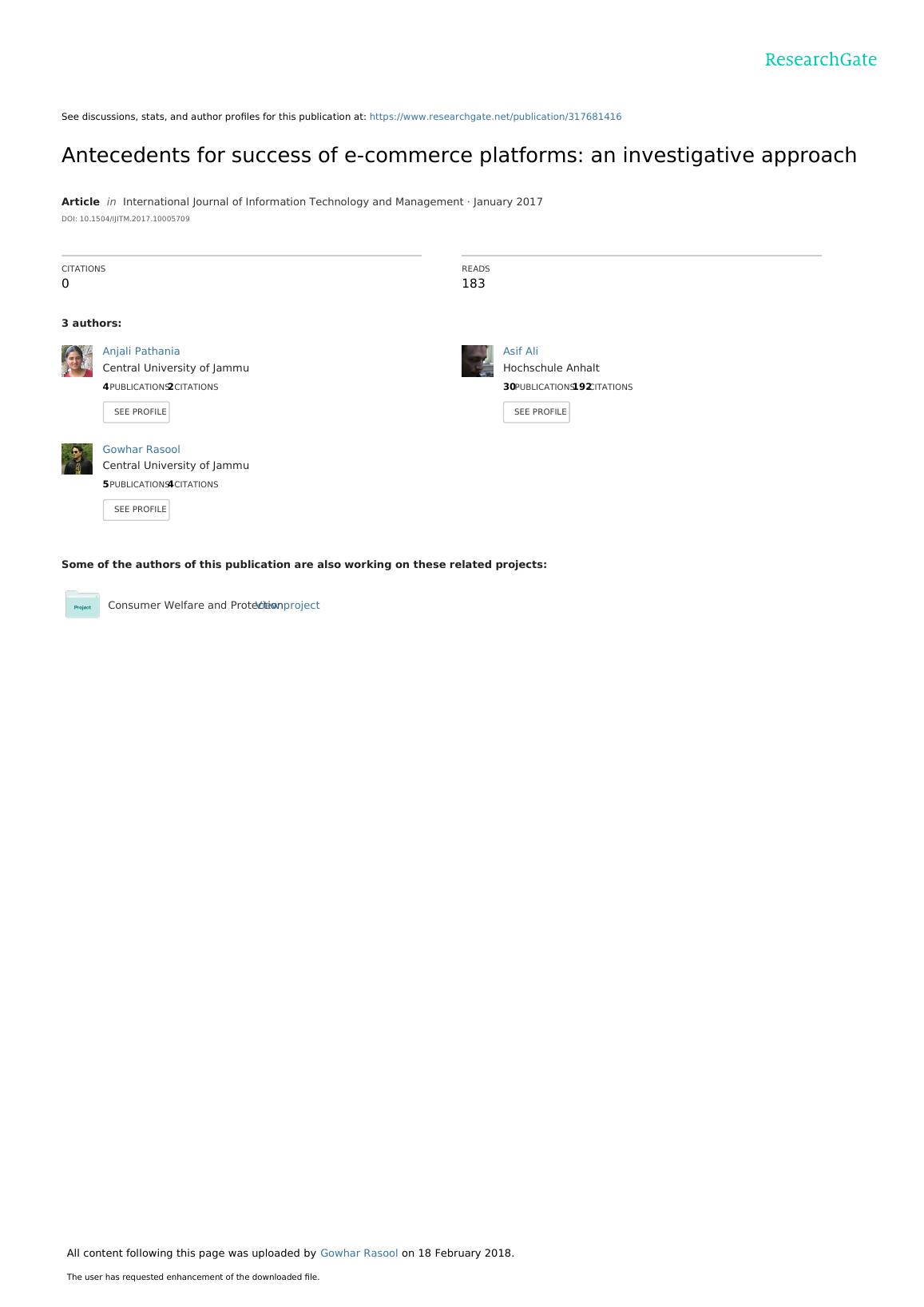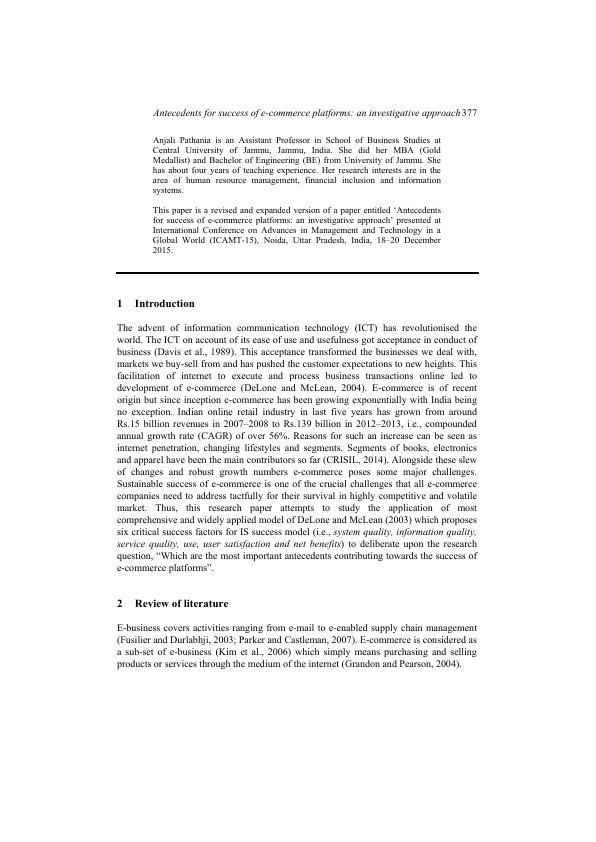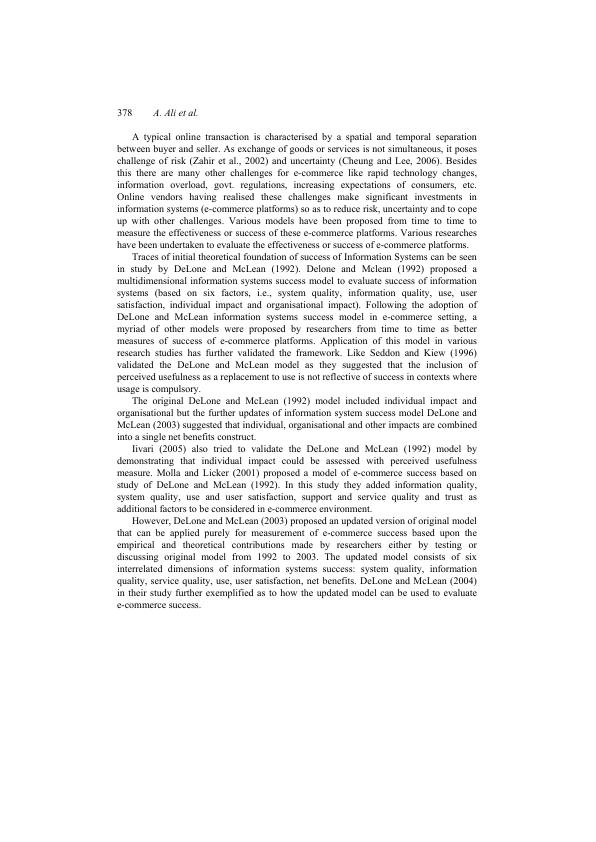Success of E-commerce Platforms Information 2022
16 Pages6630 Words16 Views
Added on 2022-08-25
About This Document
Please develop a table of at least 25 articles Citation Research objectives Methodology Findings Conclusion/Future research Find answers to these questions 1- what are the important infrastructure needed in a company and a country to make e-commerce work 2- success factors for e-commerce adoption 3- e-commerce in airlines 4- code sharing 5- competiteve advantage 6- the personalization through e- commerce all those related chapter 2
Success of E-commerce Platforms Information 2022
Added on 2022-08-25
ShareRelated Documents
See discussions, stats, and author profiles for this publication at: https://www.researchgate.net/publication/317681416
Antecedents for success of e-commerce platforms: an investigative approach
Article in International Journal of Information Technology and Management · January 2017
DOI: 10.1504/IJITM.2017.10005709
CITATIONS
0
READS
183
3 authors:
Some of the authors of this publication are also working on these related projects:
Consumer Welfare and Protection View project
Anjali Pathania
Central University of Jammu
4 PUBLICATIONS 2 CITATIONS
SEE PROFILE
Asif Ali
Hochschule Anhalt
30 PUBLICATIONS 192 CITATIONS
SEE PROFILE
Gowhar Rasool
Central University of Jammu
5 PUBLICATIONS 4 CITATIONS
SEE PROFILE
All content following this page was uploaded by Gowhar Rasool on 18 February 2018.
The user has requested enhancement of the downloaded file.
Antecedents for success of e-commerce platforms: an investigative approach
Article in International Journal of Information Technology and Management · January 2017
DOI: 10.1504/IJITM.2017.10005709
CITATIONS
0
READS
183
3 authors:
Some of the authors of this publication are also working on these related projects:
Consumer Welfare and Protection View project
Anjali Pathania
Central University of Jammu
4 PUBLICATIONS 2 CITATIONS
SEE PROFILE
Asif Ali
Hochschule Anhalt
30 PUBLICATIONS 192 CITATIONS
SEE PROFILE
Gowhar Rasool
Central University of Jammu
5 PUBLICATIONS 4 CITATIONS
SEE PROFILE
All content following this page was uploaded by Gowhar Rasool on 18 February 2018.
The user has requested enhancement of the downloaded file.

376 Int. J. Information Technology and Management, Vol. 16, No. 4, 2017
Copyright © 2017 Inderscience Enterprises Ltd.
Antecedents for success of e-commerce platforms:
an investigative approach
Asif Ali*, Gowhar Rasool and Anjali Pathania
Department of HRM and OB,
Central University of Jammu,
Jammu, India
Email: easif.101@gmail.com
Email: gowhar2@gmail.com
Email: anjalipathania88@gmail.com
*Corresponding author
Abstract: A plethora of literature is available highlighting the critical success
factors (CSFs) of information systems (IS). While most of the studies were
elusive in determining CSFs, the research of DeLone and McLean (1992)
proposed an IS success model which is most comprehensive and widely applied
model in various research studies carried out in this context. The model was
later updated to incorporate parsimony by DeLone and McLean (2003). The
updated model is based on six success factors, i.e., system quality, information,
service quality use, user satisfaction and net benefits. This paper attempts to
examine the role of each critical success factors as suggested by DeLone and
McLean (2003) towards the success of e-commerce platforms and how it can
be leveraged for enhancing customer value by laying strong foundation on most
vital factor. DeLone and McLean (2003) model was applied to make a
comparison between Flipkart and Snapdeal which are two dominant players of
e-commerce in India, so as to investigate the antecedents for the success of
e-commerce platforms.
Keywords: information systems; e-commerce platforms; user experiences;
critical success factors.
Reference to this paper should be made as follows: Ali, A., Rasool, G. and
Pathania, A. (2017) ‘Antecedents for success of e-commerce platforms: an
investigative approach’, Int. J. Information Technology and Management,
Vol. 16, No. 4, pp.376–390.
Biographical notes: Asif Ali is an Assistant Professor in School of Business
Studies at Central University of Jammu, Jammu, India. He did his MBA from
University of Kashmir and is a Junior Associate from Indian Institute of
Banking and Finance. He has about three years of corporate and one and a half
years of teaching experience. His research interests are in the area of finance,
organisational behaviour and e-commerce.
Gowhar Rasool is an Assistant Professor in School of Business Studies at
Central University of Jammu, Jammu, India. He did his MBA in the area of HR
and has also done international business from UNCC, USA. He has about one
year of corporate and two years of teaching experience. His research interests
are in the area of quantitative research methods, human resource management
and financial inclusion.
Copyright © 2017 Inderscience Enterprises Ltd.
Antecedents for success of e-commerce platforms:
an investigative approach
Asif Ali*, Gowhar Rasool and Anjali Pathania
Department of HRM and OB,
Central University of Jammu,
Jammu, India
Email: easif.101@gmail.com
Email: gowhar2@gmail.com
Email: anjalipathania88@gmail.com
*Corresponding author
Abstract: A plethora of literature is available highlighting the critical success
factors (CSFs) of information systems (IS). While most of the studies were
elusive in determining CSFs, the research of DeLone and McLean (1992)
proposed an IS success model which is most comprehensive and widely applied
model in various research studies carried out in this context. The model was
later updated to incorporate parsimony by DeLone and McLean (2003). The
updated model is based on six success factors, i.e., system quality, information,
service quality use, user satisfaction and net benefits. This paper attempts to
examine the role of each critical success factors as suggested by DeLone and
McLean (2003) towards the success of e-commerce platforms and how it can
be leveraged for enhancing customer value by laying strong foundation on most
vital factor. DeLone and McLean (2003) model was applied to make a
comparison between Flipkart and Snapdeal which are two dominant players of
e-commerce in India, so as to investigate the antecedents for the success of
e-commerce platforms.
Keywords: information systems; e-commerce platforms; user experiences;
critical success factors.
Reference to this paper should be made as follows: Ali, A., Rasool, G. and
Pathania, A. (2017) ‘Antecedents for success of e-commerce platforms: an
investigative approach’, Int. J. Information Technology and Management,
Vol. 16, No. 4, pp.376–390.
Biographical notes: Asif Ali is an Assistant Professor in School of Business
Studies at Central University of Jammu, Jammu, India. He did his MBA from
University of Kashmir and is a Junior Associate from Indian Institute of
Banking and Finance. He has about three years of corporate and one and a half
years of teaching experience. His research interests are in the area of finance,
organisational behaviour and e-commerce.
Gowhar Rasool is an Assistant Professor in School of Business Studies at
Central University of Jammu, Jammu, India. He did his MBA in the area of HR
and has also done international business from UNCC, USA. He has about one
year of corporate and two years of teaching experience. His research interests
are in the area of quantitative research methods, human resource management
and financial inclusion.

Antecedents for success of e-commerce platforms: an investigative approach 377
Anjali Pathania is an Assistant Professor in School of Business Studies at
Central University of Jammu, Jammu, India. She did her MBA (Gold
Medallist) and Bachelor of Engineering (BE) from University of Jammu. She
has about four years of teaching experience. Her research interests are in the
area of human resource management, financial inclusion and information
systems.
This paper is a revised and expanded version of a paper entitled ‘Antecedents
for success of e-commerce platforms: an investigative approach’ presented at
International Conference on Advances in Management and Technology in a
Global World (ICAMT-15), Noida, Uttar Pradesh, India, 18–20 December
2015.
1 Introduction
The advent of information communication technology (ICT) has revolutionised the
world. The ICT on account of its ease of use and usefulness got acceptance in conduct of
business (Davis et al., 1989). This acceptance transformed the businesses we deal with,
markets we buy-sell from and has pushed the customer expectations to new heights. This
facilitation of internet to execute and process business transactions online led to
development of e-commerce (DeLone and McLean, 2004). E-commerce is of recent
origin but since inception e-commerce has been growing exponentially with India being
no exception. Indian online retail industry in last five years has grown from around
Rs.15 billion revenues in 2007–2008 to Rs.139 billion in 2012–2013, i.e., compounded
annual growth rate (CAGR) of over 56%. Reasons for such an increase can be seen as
internet penetration, changing lifestyles and segments. Segments of books, electronics
and apparel have been the main contributors so far (CRISIL, 2014). Alongside these slew
of changes and robust growth numbers e-commerce poses some major challenges.
Sustainable success of e-commerce is one of the crucial challenges that all e-commerce
companies need to address tactfully for their survival in highly competitive and volatile
market. Thus, this research paper attempts to study the application of most
comprehensive and widely applied model of DeLone and McLean (2003) which proposes
six critical success factors for IS success model (i.e., system quality, information quality,
service quality, use, user satisfaction and net benefits) to deliberate upon the research
question, “Which are the most important antecedents contributing towards the success of
e-commerce platforms”.
2 Review of literature
E-business covers activities ranging from e-mail to e-enabled supply chain management
(Fusilier and Durlabhji, 2003; Parker and Castleman, 2007). E-commerce is considered as
a sub-set of e-business (Kim et al., 2006) which simply means purchasing and selling
products or services through the medium of the internet (Grandon and Pearson, 2004).
Anjali Pathania is an Assistant Professor in School of Business Studies at
Central University of Jammu, Jammu, India. She did her MBA (Gold
Medallist) and Bachelor of Engineering (BE) from University of Jammu. She
has about four years of teaching experience. Her research interests are in the
area of human resource management, financial inclusion and information
systems.
This paper is a revised and expanded version of a paper entitled ‘Antecedents
for success of e-commerce platforms: an investigative approach’ presented at
International Conference on Advances in Management and Technology in a
Global World (ICAMT-15), Noida, Uttar Pradesh, India, 18–20 December
2015.
1 Introduction
The advent of information communication technology (ICT) has revolutionised the
world. The ICT on account of its ease of use and usefulness got acceptance in conduct of
business (Davis et al., 1989). This acceptance transformed the businesses we deal with,
markets we buy-sell from and has pushed the customer expectations to new heights. This
facilitation of internet to execute and process business transactions online led to
development of e-commerce (DeLone and McLean, 2004). E-commerce is of recent
origin but since inception e-commerce has been growing exponentially with India being
no exception. Indian online retail industry in last five years has grown from around
Rs.15 billion revenues in 2007–2008 to Rs.139 billion in 2012–2013, i.e., compounded
annual growth rate (CAGR) of over 56%. Reasons for such an increase can be seen as
internet penetration, changing lifestyles and segments. Segments of books, electronics
and apparel have been the main contributors so far (CRISIL, 2014). Alongside these slew
of changes and robust growth numbers e-commerce poses some major challenges.
Sustainable success of e-commerce is one of the crucial challenges that all e-commerce
companies need to address tactfully for their survival in highly competitive and volatile
market. Thus, this research paper attempts to study the application of most
comprehensive and widely applied model of DeLone and McLean (2003) which proposes
six critical success factors for IS success model (i.e., system quality, information quality,
service quality, use, user satisfaction and net benefits) to deliberate upon the research
question, “Which are the most important antecedents contributing towards the success of
e-commerce platforms”.
2 Review of literature
E-business covers activities ranging from e-mail to e-enabled supply chain management
(Fusilier and Durlabhji, 2003; Parker and Castleman, 2007). E-commerce is considered as
a sub-set of e-business (Kim et al., 2006) which simply means purchasing and selling
products or services through the medium of the internet (Grandon and Pearson, 2004).

378 A. Ali et al.
A typical online transaction is characterised by a spatial and temporal separation
between buyer and seller. As exchange of goods or services is not simultaneous, it poses
challenge of risk (Zahir et al., 2002) and uncertainty (Cheung and Lee, 2006). Besides
this there are many other challenges for e-commerce like rapid technology changes,
information overload, govt. regulations, increasing expectations of consumers, etc.
Online vendors having realised these challenges make significant investments in
information systems (e-commerce platforms) so as to reduce risk, uncertainty and to cope
up with other challenges. Various models have been proposed from time to time to
measure the effectiveness or success of these e-commerce platforms. Various researches
have been undertaken to evaluate the effectiveness or success of e-commerce platforms.
Traces of initial theoretical foundation of success of Information Systems can be seen
in study by DeLone and McLean (1992). Delone and Mclean (1992) proposed a
multidimensional information systems success model to evaluate success of information
systems (based on six factors, i.e., system quality, information quality, use, user
satisfaction, individual impact and organisational impact). Following the adoption of
DeLone and McLean information systems success model in e-commerce setting, a
myriad of other models were proposed by researchers from time to time as better
measures of success of e-commerce platforms. Application of this model in various
research studies has further validated the framework. Like Seddon and Kiew (1996)
validated the DeLone and McLean model as they suggested that the inclusion of
perceived usefulness as a replacement to use is not reflective of success in contexts where
usage is compulsory.
The original DeLone and McLean (1992) model included individual impact and
organisational but the further updates of information system success model DeLone and
McLean (2003) suggested that individual, organisational and other impacts are combined
into a single net benefits construct.
Iivari (2005) also tried to validate the DeLone and McLean (1992) model by
demonstrating that individual impact could be assessed with perceived usefulness
measure. Molla and Licker (2001) proposed a model of e-commerce success based on
study of DeLone and McLean (1992). In this study they added information quality,
system quality, use and user satisfaction, support and service quality and trust as
additional factors to be considered in e-commerce environment.
However, DeLone and McLean (2003) proposed an updated version of original model
that can be applied purely for measurement of e-commerce success based upon the
empirical and theoretical contributions made by researchers either by testing or
discussing original model from 1992 to 2003. The updated model consists of six
interrelated dimensions of information systems success: system quality, information
quality, service quality, use, user satisfaction, net benefits. DeLone and McLean (2004)
in their study further exemplified as to how the updated model can be used to evaluate
e-commerce success.
A typical online transaction is characterised by a spatial and temporal separation
between buyer and seller. As exchange of goods or services is not simultaneous, it poses
challenge of risk (Zahir et al., 2002) and uncertainty (Cheung and Lee, 2006). Besides
this there are many other challenges for e-commerce like rapid technology changes,
information overload, govt. regulations, increasing expectations of consumers, etc.
Online vendors having realised these challenges make significant investments in
information systems (e-commerce platforms) so as to reduce risk, uncertainty and to cope
up with other challenges. Various models have been proposed from time to time to
measure the effectiveness or success of these e-commerce platforms. Various researches
have been undertaken to evaluate the effectiveness or success of e-commerce platforms.
Traces of initial theoretical foundation of success of Information Systems can be seen
in study by DeLone and McLean (1992). Delone and Mclean (1992) proposed a
multidimensional information systems success model to evaluate success of information
systems (based on six factors, i.e., system quality, information quality, use, user
satisfaction, individual impact and organisational impact). Following the adoption of
DeLone and McLean information systems success model in e-commerce setting, a
myriad of other models were proposed by researchers from time to time as better
measures of success of e-commerce platforms. Application of this model in various
research studies has further validated the framework. Like Seddon and Kiew (1996)
validated the DeLone and McLean model as they suggested that the inclusion of
perceived usefulness as a replacement to use is not reflective of success in contexts where
usage is compulsory.
The original DeLone and McLean (1992) model included individual impact and
organisational but the further updates of information system success model DeLone and
McLean (2003) suggested that individual, organisational and other impacts are combined
into a single net benefits construct.
Iivari (2005) also tried to validate the DeLone and McLean (1992) model by
demonstrating that individual impact could be assessed with perceived usefulness
measure. Molla and Licker (2001) proposed a model of e-commerce success based on
study of DeLone and McLean (1992). In this study they added information quality,
system quality, use and user satisfaction, support and service quality and trust as
additional factors to be considered in e-commerce environment.
However, DeLone and McLean (2003) proposed an updated version of original model
that can be applied purely for measurement of e-commerce success based upon the
empirical and theoretical contributions made by researchers either by testing or
discussing original model from 1992 to 2003. The updated model consists of six
interrelated dimensions of information systems success: system quality, information
quality, service quality, use, user satisfaction, net benefits. DeLone and McLean (2004)
in their study further exemplified as to how the updated model can be used to evaluate
e-commerce success.

End of preview
Want to access all the pages? Upload your documents or become a member.
